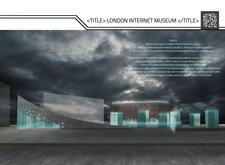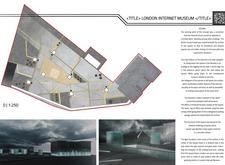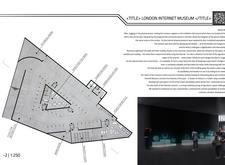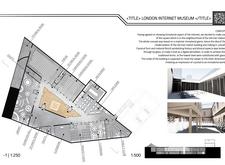5 key facts about this project
The project is designed with the intention of making the intangible aspects of the internet comprehensible and accessible. By harnessing the physicality of architecture, the museum invites visitors to engage with digital history, the evolution of internet technologies, and their impact on society. The building’s structure is partially subterranean, a thoughtful choice that symbolizes the immersive nature of entering the digital world—akin to logging into an online platform. This design concept creates a unique atmosphere that encourages exploration and discovery.
The architectural approach of the museum incorporates dynamic forms that reflect the fluidity of digital communication. Curvilinear walls encase the visitor experience, evoking a sense of movement and connection. The seamless integration of glass façades enhances this theme by establishing a visual continuity between the exterior environment and the interior space. Natural light plays a significant role in the design, creating an inviting ambiance that fosters interaction among visitors.
To facilitate a wide array of functions, the internal layout is strategically organized to accommodate various visitor experiences. Exhibition halls, classrooms, and collaborative spaces feature flexible designs that can adapt to changing uses and diverse programming. This adaptability is essential for a museum focused on a subject as fast-evolving as the internet. Interactive media elements, such as holographic displays, are woven throughout the displays, ensuring that the experience engages visitors on multiple levels.
A noteworthy aspect of this architectural design is how it engages with the surrounding landscape. The project integrates outdoor elements that resemble digital pathways, a visual metaphor for both the architectural experience and the interconnected nature of contemporary life. This landscaping approach enhances the overall visitor experience and emphasizes the museum’s thematic focus on connectivity and networked communication.
Materiality in the London Internet Museum has been thoughtfully considered to align with the project's overarching narrative. Concrete is used as a primary material, introducing a sense of permanence that contrasts with the ephemeral nature of the internet. Glass is utilized extensively, allowing for transparency and a constant interchange between the inside and outside world. Copper features, reminiscent of circuitry, serve as both functional and artistic elements, reinforcing the museum’s theme of technology and connectivity.
Moreover, the design incorporates elements such as panoramic elevators that connect different levels of the museum. These elevators not only provide accessibility but also symbolize the vertical nature of knowledge and discovery. A unique chip-entry system enhances user experience by allowing visitors to interact with the exhibits in a personalized manner. These design choices reflect a comprehensive understanding of how physical spaces can enhance engagement with digital content.
The London Internet Museum represents a significant step in how architecture can interpret and respond to contemporary issues surrounding technology and culture. By creating a space that acknowledges the impact of the internet while providing a platform for education and interaction, the project contributes to a growing dialogue about digital literacy and cultural preservation. For those interested in delving deeper into the architectural narrative, exploring the architectural plans, sections, designs, and innovative ideas behind the museum will provide valuable insights into this unique project.


























